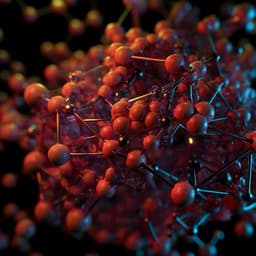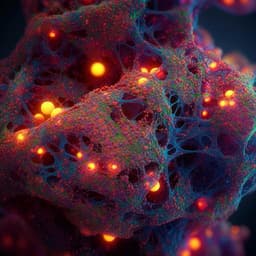
Physics
Three-dimensional imaging of ferroaxial domains using circularly polarized second harmonic generation microscopy
H. Yokota, T. Hayashida, et al.
Dive into the intriguing world of ferroaxial order! This innovative research by Hiroko Yokota, Takeshi Hayashida, Dan Kitahara, and Tsuyoshi Kimura employs circular intensity difference in second harmonic generation microscopy to visualize complex domain structures in NiTiO3, showcasing remarkable potential for nonlinear optical manipulations.
~3 min • Beginner • English
Introduction
Ferroaxial order is a recently recognized class of ferroic ordering characterized by a rotational structural distortion that can be described by a ferroaxial (electric toroidal) moment A = Σ r × p. Although A is even under time reversal and spatial inversion, it breaks certain mirror symmetries, producing two domain states with opposite signs of A. Identifying the sign of A (i.e., distinguishing ferroaxial domains) has been challenging compared with chiral detection. Recent demonstrations using rotational anisotropy second harmonic generation (SHG) and electrogyration (EG) proved that ferroaxial domains can be detected, stimulating interest in associated unconventional responses. SHG, being sensitive to symmetry breaking and higher-order multipoles in centrosymmetric crystals, provides an avenue to probe ferroaxial order. Here, we propose and demonstrate that circular intensity difference in SHG (CID-SHG) can identify ferroaxial domain states in the centrosymmetric ferroaxial crystal NiTiO3, enabling three-dimensional (3D) imaging of domains from the surface into the bulk with sub-micrometer resolution by exploiting magnetic-dipole (MD) and electric-quadrupole (EQ) contributions near optical resonance.
Literature Review
Prior work identified ferroaxial order and its symmetry properties and predicted novel transverse and thermally driven responses associated with the ferroaxial moment. Experimentally, ferroaxial domains were observed using rotational anisotropy SHG (largely attributed to EQ contributions) and EG. SHG circular dichroism has been widely used to probe chirality in molecules and biomaterials, while in centrosymmetric crystals SHG can arise via higher-order multipoles (MD, EQ), with resonant enhancement near electronic transitions such as d–d excitations. A related ilmenite, MnTiO3, exhibited circular-polarization-dependent SHG interpreted through MD processes, motivating the application of such effects to ferroaxial order in NiTiO3.
Methodology
Theory: NiTiO3 at room temperature has ilmenite structure with ferroaxial point group 3 (centrosymmetric). Electric-dipole SHG is forbidden, but magnetic-dipole (MD) and electric-quadrupole (EQ) contributions are allowed. Focusing on MD (EQ yields the same SHG form), the nonlinear magnetization is M_MD(2ω) ∝ χ_ijk^MD E_j(ω)E_k(ω). For light propagating along the hexagonal c axis (z direction), only two independent susceptibility components are relevant. The SHG source term involves these components and the circular polarization components E_±. Near resonance (complex susceptibilities), the SH intensity under circularly polarized excitation contains a term proportional to (χ_xyz^(2)' χ_xxx^(1)' − χ_xyz^(2)' χ_yyy^(1)') (E_+^2 − E_-^2), yielding different intensities for right- (RCP) and left-handed (LCP) circular polarizations (CID-SHG). A+ and A− ferroaxial domains are interconverted by a mirror with plane ∥ (110), which changes the sign of χ^(2) but not χ^(1), reversing the sign of the circular-dependent term; thus RCP/LCP contrast identifies domain sign.
Sample preparation: Single-crystal NiTiO3 was grown by flux method, verified by X-ray diffraction. As-grown crystals (3×3×0.1 mm³, widest faces ⟂ c) were single-domain. To create multidomain states, crystals were annealed in air from 1623 K with 1 K/h cooling rate, then polished to 20–60 µm thickness for SHG.
SHG microscopy: Measurements at room temperature used a scanning transmission confocal microscope. Fundamental light from a femtosecond optical parametric oscillator (Avesta TOPOL) provided 680–1000 nm and 1100–2300 nm; primarily 1200 nm wavelength, 80 MHz repetition, 125 fs pulse width. Power was controlled by half-wave plate + Glan–Taylor prism attenuator. Circular polarization generated by a quarter-wave plate; degree of circular polarization ≈90%. Excitation along c axis. Confocal setup with objectives NA = 0.65 and a pinhole; SH collected by photon counting. 2D images obtained by galvanometer scanning; depth-resolved stacks via a motorized z-scan to reconstruct 3D images. Spatial resolution ≈0.56 µm lateral and ≈3 µm axial. Wavelength-dependent measurements covered 1200–1380 nm to probe resonance near the Ni2+ 3A2g → 3T2g transition.
Key Findings
- Strong CID-SHG in NiTiO3: Two-dimensional SHG images under RCP and LCP illumination show pronounced contrast reversal between adjacent regions, corresponding to A+ and A− ferroaxial domains.
- Quantitative CID: The normalized circular intensity difference ΔI/I_AVE = (I_RCP − I_LCP)/[(I_RCP + I_LCP)/2] ranges from 0.6 to 1.3, indicating SHG intensity strongly depends on circular polarization. The inter-domain contrast under RCP, [I_RCP(A+) − I_RCP(A−)]/[(I_RCP(A+) + I_RCP(A−))/2], is 32%.
- Spectral dependence: ΔI/I_AVE decreases as the fundamental wavelength increases from 1200 to 1380 nm, consistent with resonance near the Ni2+ d–d transition (3A2g → 3T2g).
- 3D imaging: Depth-resolved SHG shows nearly constant SH intensity with depth, demonstrating bulk sensitivity and enabling 3D visualization of domain structures.
- Domain size and morphology: Domains exhibit irregular shapes with sub-millimeter lateral dimensions; TiO2 impurity inclusions appear as branch-like patterns in transmission images but are distinct from domain contrast.
- Validation with EG: CID-SHG domain patterns match those obtained by electrogyration mapping on the same sample, confirming assignment of bright/dark areas to opposite ferroaxial domain states.
- Domain boundary (DB) enhancement: SHG intensity at DBs is enhanced by a factor of ~3–10 relative to domains, independent of incident polarization (RCP, LCP, or linear). 3D profiling shows DBs are nearly perpendicular to the surface with uniform SH intensity along depth, indicating a bulk effect.
- Fringe features at tilted DBs: Fringe-like SHG patterns occur where EG indicates thicker, tilted DBs; fringe period increases with incident wavelength, suggesting interference between SHG from neighboring domains and/or nonlinear Čerenkov-type SHG contributions at DBs.
Discussion
The observations confirm that CID-SHG arising from higher-order multipoles (MD and EQ) provides a direct and sensitive probe of ferroaxial order in centrosymmetric crystals. The opposite circular-polarization dependence in A+ versus A− domains, dictated by symmetry (mirror operation reversing χ^(2) but not χ^(1)), enables unambiguous domain identification. The strong circular contrast and its resonance behavior near the Ni2+ d–d transition underpin high sensitivity and facilitate non-destructive 3D domain imaging. Agreement between CID-SHG maps and EG-based domain patterns validates the method. The enhanced SHG at DBs, irrespective of polarization, indicates additional nonlinear processes at boundaries; interference effects and nonlinear Čerenkov SHG are plausible mechanisms, though polarization-induced ED contributions appear unlikely given the modest contrast relative to ferroelastics. Compared with rotational anisotropy SHG and EG, CID-SHG offers larger inter-domain signal differences, electrode-free operation, and volumetric imaging capabilities, expanding the toolkit for studying ferroaxial phenomena and potential nonlinear optical functionalities.
Conclusion
CID-SHG microscopy was introduced and demonstrated as a powerful technique to detect and three-dimensionally image ferroaxial domains in centrosymmetric NiTiO3. A large circular intensity difference (>60% normalized) between opposite ferroaxial domains, consistent with MD/EQ-mediated SHG and symmetry analysis, enabled clear mapping of domain structures throughout the sample depth. Corroboration with EG measurements confirms that CID-SHG contrast reflects ferroaxial domain states. The method’s high sensitivity, depth sectioning, and electrode-free implementation highlight its advantages over existing probes. Future work could generalize CID-SHG to other ferroaxial materials, optimize spectral conditions for maximal contrast, quantify the relative MD versus EQ contributions, and elucidate the microscopic origin of enhanced SHG and fringe patterns at domain boundaries.
Limitations
- The theoretical analysis emphasized MD contributions while noting EQ yields the same SHG form; quantitative separation of MD and EQ was not performed.
- Enhancement of SHG at domain boundaries was observed, but its origin (e.g., nonlinear Čerenkov SHG, interference) remains to be conclusively determined; no definitive evidence for polar DBs was found.
- The degree of circular polarization (~90%) and confocal resolution (~0.56 µm lateral, ~3 µm axial) set practical limits on contrast and spatial resolution.
- Presence of TiO2 impurities may perturb local imaging areas, though domain contrast is otherwise homogeneous.
- Study conducted at room temperature and specific wavelength ranges; broader temperature and spectral mapping could refine understanding of resonance effects.
Related Publications
Explore these studies to deepen your understanding of the subject.







